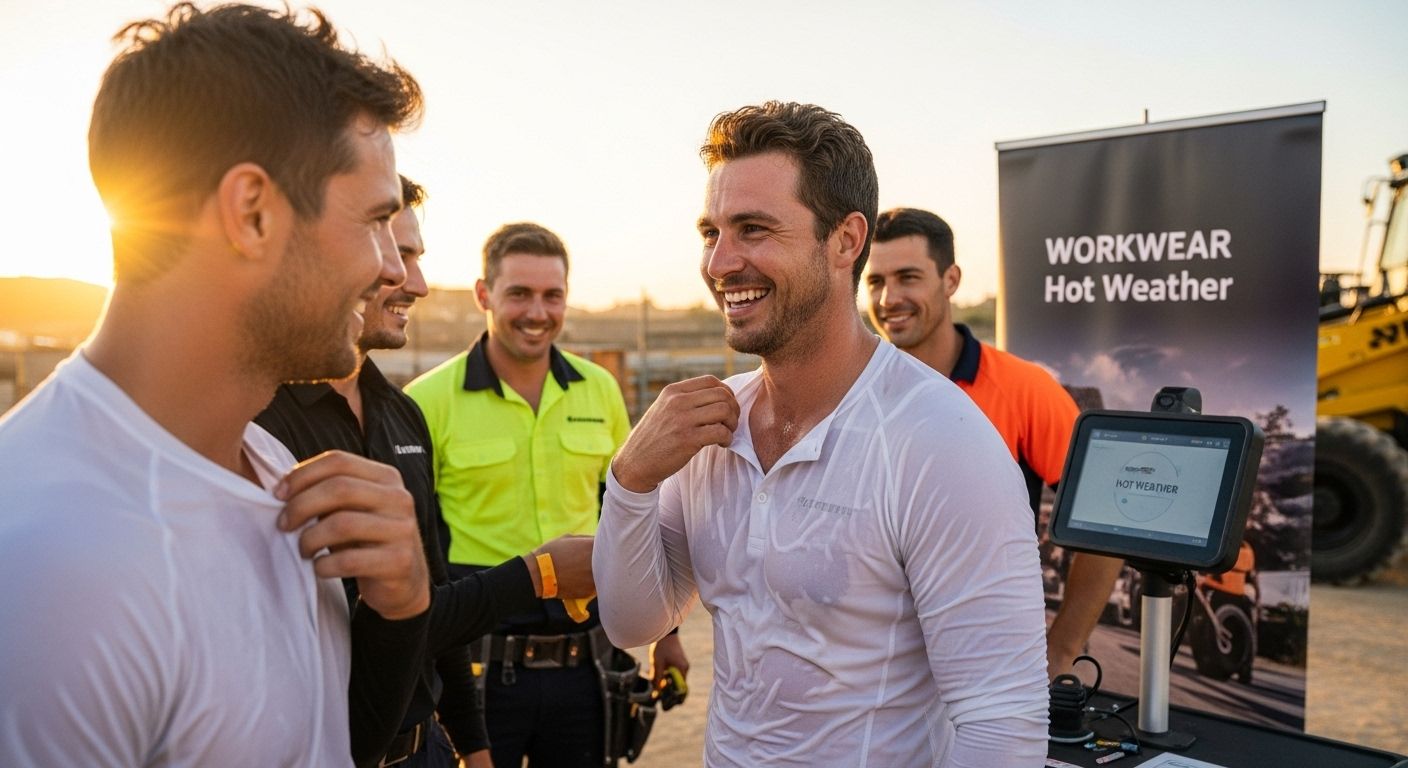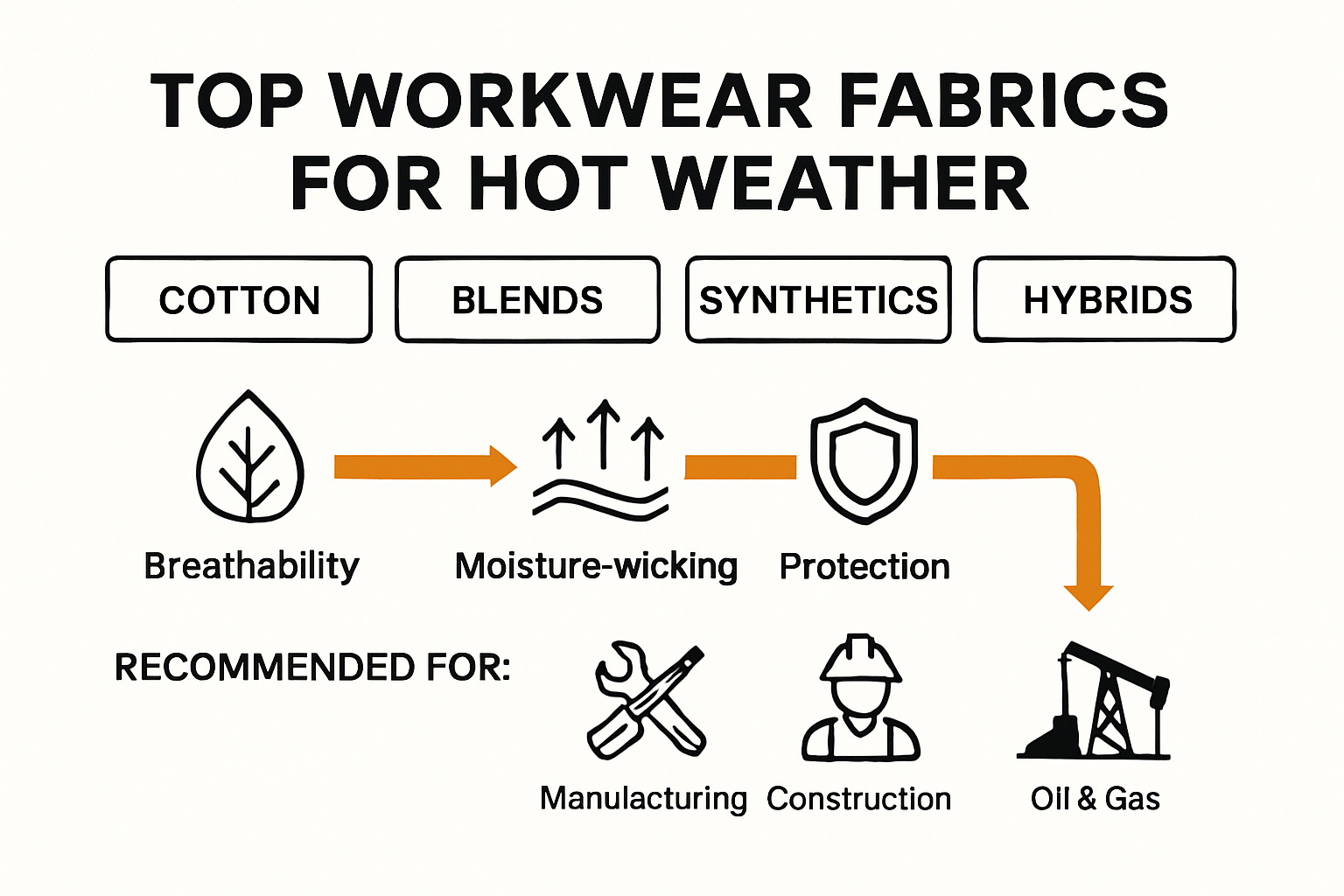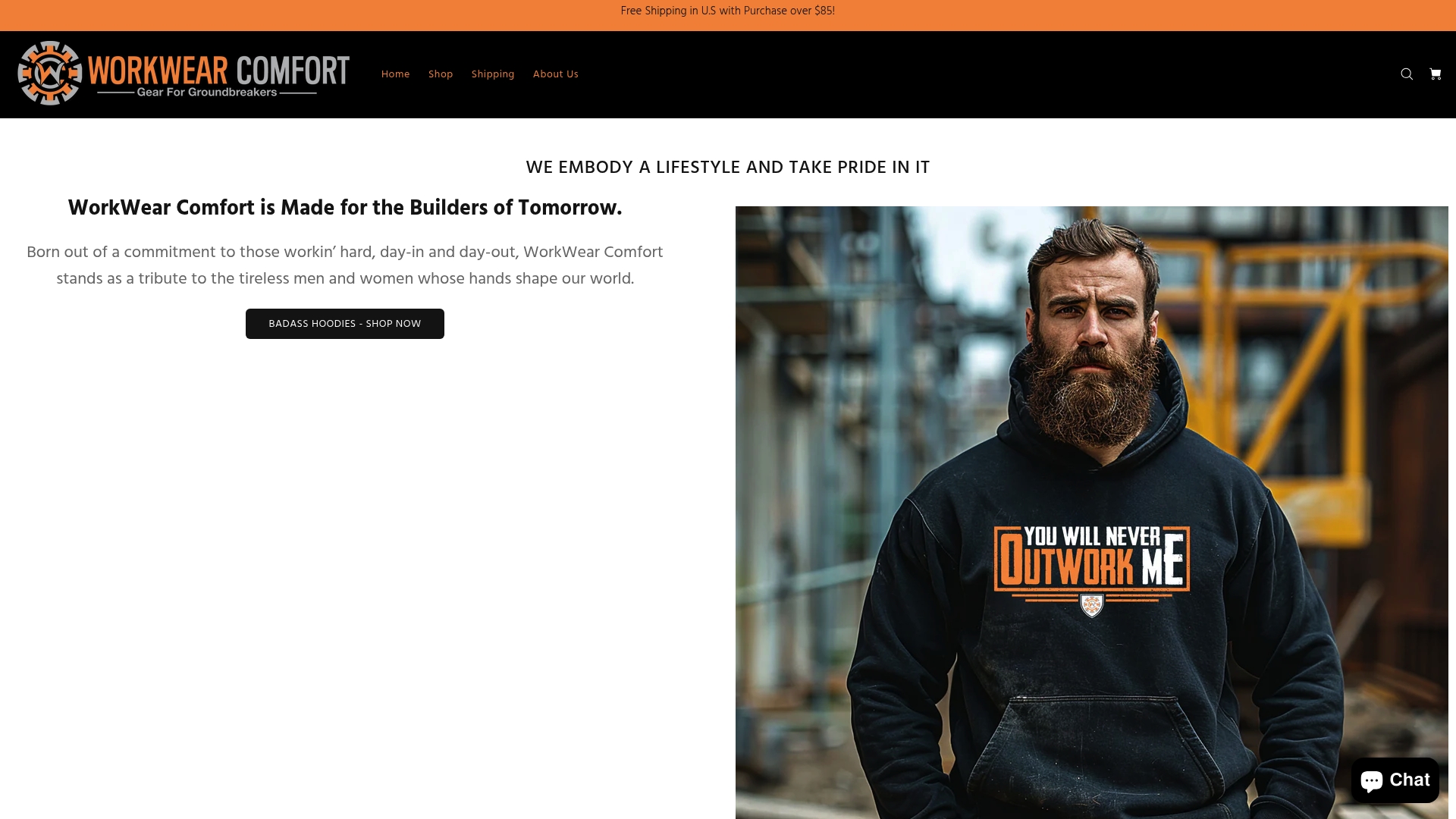
Finding the right workwear for blazing hot days feels impossible when the sun is beating down and sweat soaks through your shirt before lunch. Most people think cotton is the answer. Turns out, the best fabrics actually blend cotton with high-tech synthetics for unbeatable breathability. In fact, technical weave shirts can keep you up to 30 percent cooler than old-school basics. Get ready to rethink everything you thought you knew about hot weather comfort.
Table of Contents
- Key Features Of Hot Weather Workwear
- Top Fabrics And Materials For Breathability
- Best Work Clothing Picks For Men And Women
- Care, Maintenance, And Comfort Tips

Quick Summary
| Takeaway | Explanation |
|---|---|
| Choose breathable fabrics for hot weather | Breathable fabrics like cotton and advanced synthetics help regulate temperature and wick moisture, keeping workers comfortable. |
| Opt for protective design features | Including ventilated panels and removable linings enhances airflow while ensuring safety under hot conditions. |
| Prioritize hydration management in workwear | Incorporate features like hydration pouches and cooling pack pockets to support temperature regulation and overall worker wellness. |
| Select appropriate clothing for specific jobs | Tailor workwear choices to job requirements, considering unique needs for both male and female professionals. |
| Maintain workwear for optimal performance | Proper care techniques like cold washing and air drying preserve the performance features and extend the longevity of hot weather garments. |
Key Features of Hot Weather Workwear
Choosing the right workwear for hot weather demands strategic consideration of fabric, design, and protective capabilities. Workers facing intense heat require clothing that goes beyond basic comfort to ensure safety, performance, and physiological well-being.
Fabric Technology and Breathability
Breathable fabrics are the cornerstone of effective hot weather workwear. According to Cal/OSHA, lightweight and loose-fitting clothing facilitates crucial air circulation and temperature regulation. Natural materials like cotton and advanced synthetic blends provide moisture-wicking properties that help workers stay dry and cool during demanding tasks.
Professional workers need fabrics that offer quick sweat evaporation and thermal management. Pharsol Protect recommends densely woven materials that allow air movement while providing adequate protection. Light colors such as white, gray, or light blue are strategically advantageous, reflecting sunlight and minimizing heat absorption.
Protective Design Elements
Hot weather workwear must balance protection with comfort. Innovative design features like ventilated panels, mesh inserts, and strategic perforations enable enhanced airflow without compromising safety standards. Workers need garments with removable linings, adjustable vents, and specialized cooling technologies.
Read our guide on sun-protective workwear to understand how advanced clothing can shield workers from harmful UV radiation while maintaining breathability. Garments with UPF 50+ ratings offer critical defense against sun exposure, which is especially important for outdoor professionals.
Hydration and Thermal Stress Management
Beyond clothing design, BlackHawk Industrial Supply emphasizes the critical role of hydration in heat management. Workwear should incorporate features that support worker wellness, such as integrated hydration pouches, cooling pack pockets, and moisture-management technologies.
Effective hot weather workwear is not just about individual clothing pieces but creating a comprehensive thermal protection system. This includes selecting garments that facilitate body temperature regulation, protect against environmental hazards, and support worker performance under challenging conditions.
Workers across various industries - from construction and agriculture to emergency services - require specialized clothing that adapts to extreme temperatures while maintaining safety and comfort. By prioritizing breathable fabrics, innovative design, and holistic thermal management, modern workwear transforms how professionals navigate hot work environments.
Below is a summary table highlighting essential hot weather workwear features and their benefits for workers. This comparison can aid in quickly evaluating which features to prioritize.
| Feature | Purpose/Benefit |
|---|---|
| Breathable Fabrics | Regulate temperature, wick moisture |
| Lightweight & Loose Fitting | Enhance air circulation, promote comfort |
| Light Colors | Reflect sunlight, reduce heat absorption |
| Ventilated Panels & Mesh Inserts | Increase airflow without compromising safety |
| Removable Linings/Vents | Allow customization for changing temperatures |
| UPF 50+ Protection | Shields from harmful UV radiation |
| Hydration/Cooling Features | Supports temperature regulation and worker wellness |
Top Fabrics and Materials for Breathability
Selecting the right fabric is crucial for workers battling heat and humidity. The material of workwear directly impacts comfort, performance, and overall worker safety in challenging environmental conditions.
Natural Fiber Performance
Natural fibers remain a cornerstone of breathable workwear. According to scientific research, cotton blends demonstrate exceptional thermal and moisture management capabilities. Cotton provides soft, comfortable coverage while allowing air circulation and sweat absorption. However, pure cotton can become heavy when saturated, making advanced fabric engineering critical.
Modern cotton blends incorporate synthetic technologies to enhance performance. These hybrid materials maintain cotton’s natural comfort while improving moisture-wicking and quick-drying properties. Workers benefit from fabrics that pull moisture away from the skin, reducing heat stress and preventing uncomfortable dampness during intense physical labor.
Technical Synthetic Innovations
Time Magazine’s research highlights synthetic fabrics like polyester and nylon as superior options for high-intensity work environments. These materials excel in moisture management, offering rapid sweat evaporation and lightweight construction. Advanced synthetic weaves create microscopic channels that facilitate airflow and temperature regulation.
Explore our sun-protective workwear collection to see how technical fabrics can provide comprehensive protection. Modern synthetic materials often incorporate additional features like UV resistance, antimicrobial treatments, and enhanced durability, making them ideal for demanding professional environments.
Hybrid Material Technologies
Cutting-edge workwear now utilizes hybrid material technologies that combine the best attributes of natural and synthetic fibers. These advanced fabrics leverage engineering techniques to create breathable, protective clothing that adapts to changing work conditions. Strategically placed mesh panels, moisture-wicking interior linings, and specialized weave patterns maximize air circulation while maintaining structural integrity.
Workers in construction, agriculture, and outdoor industries require fabrics that can withstand rigorous use while providing optimal thermal comfort. The latest material innovations focus on creating lightweight, responsive workwear that supports peak performance. By integrating intelligent design with advanced textile technologies, manufacturers are revolutionizing how professionals approach hot-weather work attire.
Choosing the right fabric is more than a comfort consideration - it’s a critical safety decision. Workers exposed to high temperatures need clothing that actively supports their physiological needs, helping them stay cool, dry, and protected throughout demanding workdays.
To help you compare material choices, here’s a table summarizing the key characteristics of natural, synthetic, and hybrid fabrics commonly used in hot weather workwear.
| Material Type | Key Examples | Main Attributes | Considerations |
|---|---|---|---|
| Natural Fibers | Cotton, Linen | Soft, breathable, absorbs sweat | Can get heavy when saturated |
| Synthetic Fibers | Polyester, Nylon | Lightweight, quick-drying, moisture-wicking | May retain odors |
| Hybrid Blends | Cotton-Poly, Modacrylic-Lyocell | Combines comfort + technical benefits | Enhanced performance, cost |
Best Work Clothing Picks for Men and Women
Choosing the right workwear for hot weather requires understanding the unique needs of different workers and their specific job environments. Effective clothing must balance protection, comfort, and performance across various professional settings.
Performance Clothing for Male Workers
Male workers in high-intensity industries need clothing that supports rigorous physical demands while managing heat effectively. Research from Georgia Tech highlights the importance of moisture-wicking fabrics like polyester with Dri-FIT technology. These materials rapidly transport sweat away from the body, preventing discomfort and potential heat-related stress.
Constructors, farmers, and outdoor laborers require durable workwear that can withstand tough conditions. Lightweight, breathable shirts with strategic ventilation and moisture-management properties offer critical protection. Cargo pants with mesh-lined pockets and reinforced knees provide both functionality and comfort in challenging work environments.
Specialized Workwear for Female Professionals
Female workers need workwear that acknowledges their unique physiological requirements and professional diversity. Discover our sun-protective workwear options designed to provide comprehensive protection while maintaining a professional aesthetic.
According to industrial textile research, advanced fabric blends incorporating modacrylic and lyocell fibers offer exceptional thermal resistance. For women in fields like agriculture, construction, and emergency services, this means clothing that adapts to changing environmental conditions while ensuring comfort and safety.
Universal Considerations for Hot Weather Workwear
Textile research emphasizes the critical role of fabric structure in managing heat and moisture. Cotton’s crystalline polymeric structure provides excellent thermal conductivity, making it a popular choice for base layers. However, workers benefit most from hybrid materials that combine natural fiber comfort with synthetic performance technologies.
Accessories play a crucial role in hot weather protection. Check out our protective headwear collection to complement your workwear ensemble. Wide-brimmed hats, moisture-wicking caps, and breathable headgear can significantly reduce heat exposure and provide additional sun protection.
Ultimately, the best workwear for hot environments transcends gender-specific design. It prioritizes worker safety, comfort, and performance through intelligent fabric selection, ergonomic design, and adaptive technologies. Whether you’re working on a construction site, farm, or in emergency services, the right clothing can make a substantial difference in your daily comfort and productivity.
Care, Maintenance, and Comfort Tips
Proper care and maintenance of workwear are essential for preserving its protective capabilities, comfort, and longevity. Workers investing in high-quality hot weather clothing must understand the nuanced approaches to maintaining their professional attire.
Washing and Preservation Techniques
The British Safety Council recommends specialized cleaning protocols for protective workwear. Moisture-wicking fabrics require gentle washing techniques to maintain their thermal regulatory properties. Always use cold water and mild detergents specifically designed for technical fabrics. Avoid fabric softeners, which can compromise moisture-management capabilities and reduce the garment’s breathability.
Drying techniques are equally critical. Air-drying workwear prevents potential fabric damage and helps maintain the structural integrity of advanced textile technologies. When machine drying is necessary, use low heat settings to prevent fiber degradation. Inspect garments after each wash for potential wear, tear, or reduced performance characteristics.
Performance Maintenance Strategies
Research published in PubMed highlights the importance of maintaining garment performance through strategic care. Thermal management properties can diminish with improper maintenance, potentially compromising worker safety in hot environments. Regularly inspect workwear for signs of wear, including thinning fabrics, reduced elasticity, or compromised protective features.
Check out our sun-protective workwear collection for additional guidance on maintaining high-performance work clothing. Rotate multiple sets of workwear to reduce individual garment stress and allow adequate recovery time between uses.
Comfort and Longevity Optimization
Industrial workwear research emphasizes that reducing garment mass and improving construction can significantly enhance thermal performance. Workers should periodically assess their clothing’s fit and functionality. As fabrics experience wear, their protective capabilities may gradually diminish.
Explore our protective headwear options to complement your workwear maintenance strategy. Accessories like wide-brimmed hats can provide additional protection and reduce overall thermal stress.

Proper workwear maintenance extends beyond cleaning. Store clothing in cool, dry environments away from direct sunlight. Avoid storing damp garments, which can promote bacterial growth and fabric degradation. Consider using breathable garment bags or storage containers that allow air circulation.
Ultimately, treating workwear as a critical piece of professional equipment ensures optimal performance, safety, and comfort. By implementing careful maintenance strategies, workers can maximize their clothing investment and maintain peak protection in challenging hot weather conditions.
Frequently Asked Questions
What are the best fabrics for hot weather workwear?
Breathable fabrics like cotton blended with advanced synthetics, such as polyester and nylon, are among the best for hot weather workwear. These materials wick moisture and allow for air circulation, keeping workers cool and comfortable.
How can I maintain my hot weather workwear for optimal performance?
To maintain hot weather workwear, wash garments in cold water with mild detergents, avoiding fabric softeners. Air-dry the clothing when possible to prevent damage and preserve moisture-wicking properties.
What design features should I look for in hot weather workwear?
Look for workwear with ventilated panels, mesh inserts, and lightweight fabrics. Additional features like removable linings and adjustable vents enhance airflow while maintaining safety and comfort in high temperatures.
Why is hydration management important in hot weather workwear?
Hydration management features, such as integrated hydration pouches and cooling pack pockets, are essential for maintaining worker wellness. These elements help regulate body temperature and prevent heat stress during high-intensity tasks.
Beat the Heat with Workwear Built for Real Life
Staying comfortable and protected during brutal summer shifts is more than just a matter of preference. As the article explained, battling sweat, sun, and soaring temperatures pushes your work clothing to its limits. You need dependable gear that actually works as hard as you do. Our UPF 50+ Sun Protection Hoodies are engineered with innovative fabric blends that keep you cool, dry, and shielded from UV rays, exactly what leading experts recommend for hot weather workwear.

Stop feeling drained by midday and start getting the support you deserve. Explore our full range for hardworking people at WorkwearComfort.com. Invest in smarter, cooler workwear and make your next shift safer and more comfortable. Your body and your productivity will thank you.


